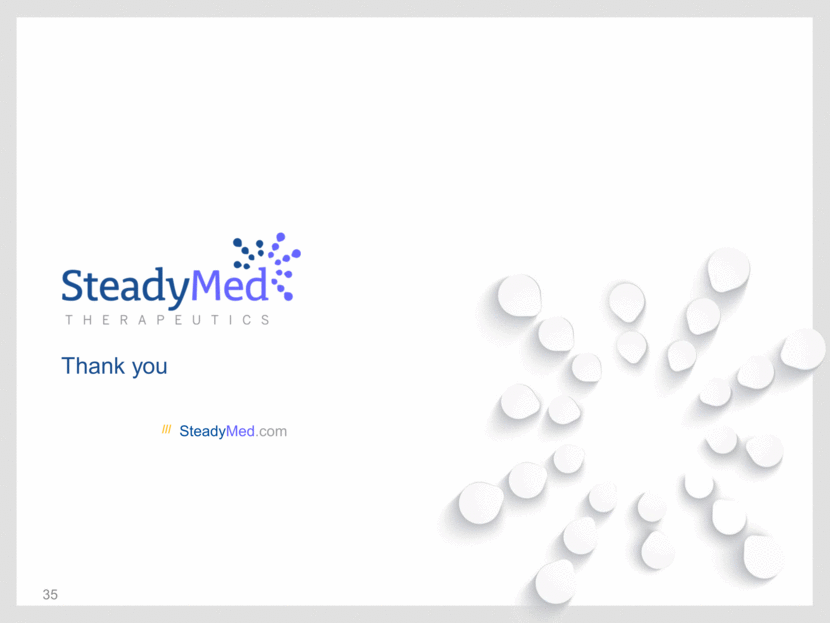Attached files
| file | filename |
|---|---|
| 8-K - 8-K - SteadyMed Ltd. | a16-5907_18k.htm |
Exhibit 99.1
PatchPump Technology INJECTABLE DRUG DELIVERY March 8, 2016 Assaf Shaked
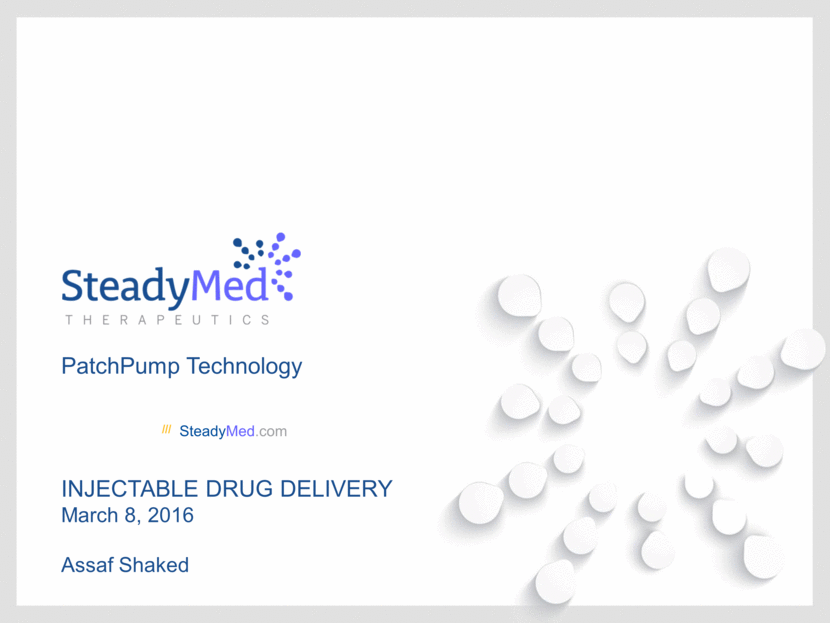
This presentation and the accompanying oral commentary (if any) contain both historical and forward-looking statements which are based on current expectations, estimates and projections. Statements that are not historical facts are forward-looking statements and typically are identified by words like “may,” “believe,” “anticipate,” “could,” “should,” “estimate,” “expect,” “intend,” “plan,” “project,” “will,” “forecast,” “approximately,” “budget,” “pro forma”, or the negative of these terms or other words that convey uncertainty of future events or outcomes to identify these forward-looking statements. All statements other than statements of historical facts contained in this presentation and the accompanying oral commentary (if any) are forward-looking statements, and include statements regarding our intentions, beliefs, projections, outlook, analyses or current expectations concerning, among other things: the development of our PatchPump technology, Trevyent and our At Home Patient Analgesia product candidates, the regulatory pathways for potential marketing approval of our product candidates, our intellectual property position, the market opportunities for our PatchPump technology , our product candidates and our cash position. Forward-looking statements involve known and unknown risks, uncertainties, assumptions and other factors that may cause our actual results, performance or achievements to be materially different from any future results, performance or achievements expressed or implied by the forward-looking statements. We discuss many of these risks in greater detail under the heading "Risk Factors" contained in our Quarterly Report on Form 10-Q for the period ending on September 30, 2015 filed with the Securities and Exchange Commission on November 12, 2015. Forward-looking statements are not guarantees of future performance and our actual results of operations, financial condition and liquidity, and the development of the industry in which we operate may differ materially from the forward-looking statements contained in this presentation and the accompanying oral commentary (if any). Any forward-looking statements that we make in this presentation and the accompanying oral commentary (if any) speak only as of the date of this presentation. The “Risk Factors” section of our Form 10-Q speaks only as of the date therefore. We assume no obligation to update our forward-looking statements whether as a result of new information, future events or otherwise. Notice Regarding Forward-Looking Statements 2
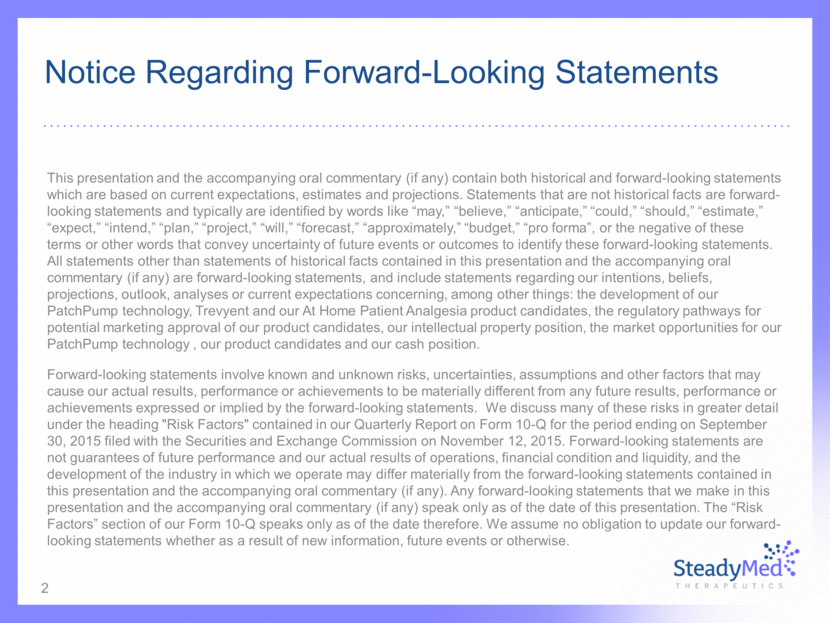
Contents Trevyent™ (treprostinil PatchPump) overview PatchPump™ Technology Pulmonary Arterial Hypertension Trevyent – components and performance Manufacturing Next generation pump from SteadyMed Integrated cannula system Large volume primary containers High volume injections Conclusion 3

We are a specialty pharmaceutical company focused on the development and commercialization of therapeutic product candidates that address the limitations of market-leading products in certain orphan and other well-defined, high-margin specialty markets.

PatchPump® Technology
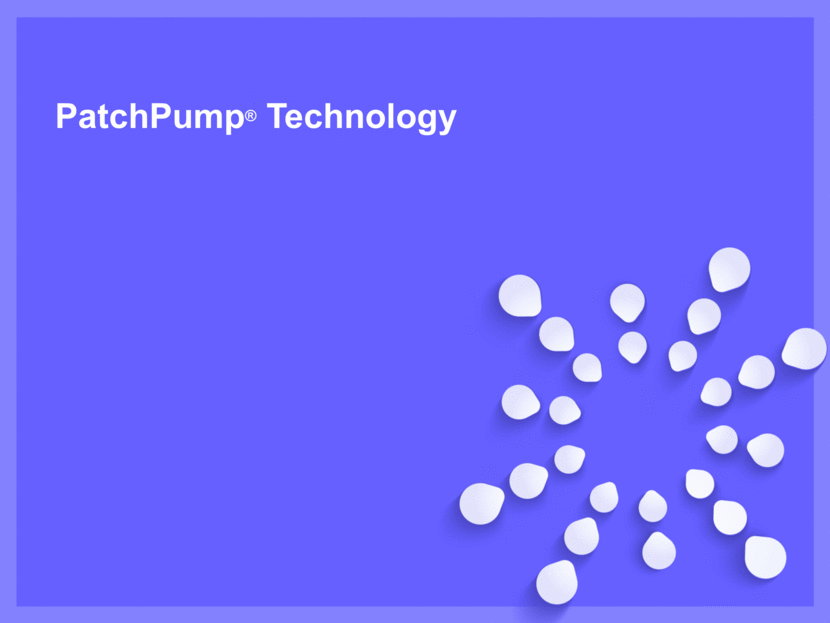
Small disposable subcutaneous or intravenous pump Accurate pre-programmed dosing and dosing period A combination of proven technologies with expanding patent protection Aseptically filled with medication at site of manufacture Simple and convenient 6 Programmable circuit board ECell Piston Primary drug container Unique Specialty Drug Product Platform

Principle of Operation The PatchPump® is a fully disposable infusion pump powered by an expanding battery (ECell®) The ECell discharges and expands by microprocessor control to push piston against the flexible wall As the primary container is compressed, liquid drug is delivered subcutaneously or intravenously The ECell® discharge rate is controlled discharge rate defines drug flow rate 7

Pulmonary Arterial Hypertension Therapy Trevyent™ (treprostinil PatchPump)
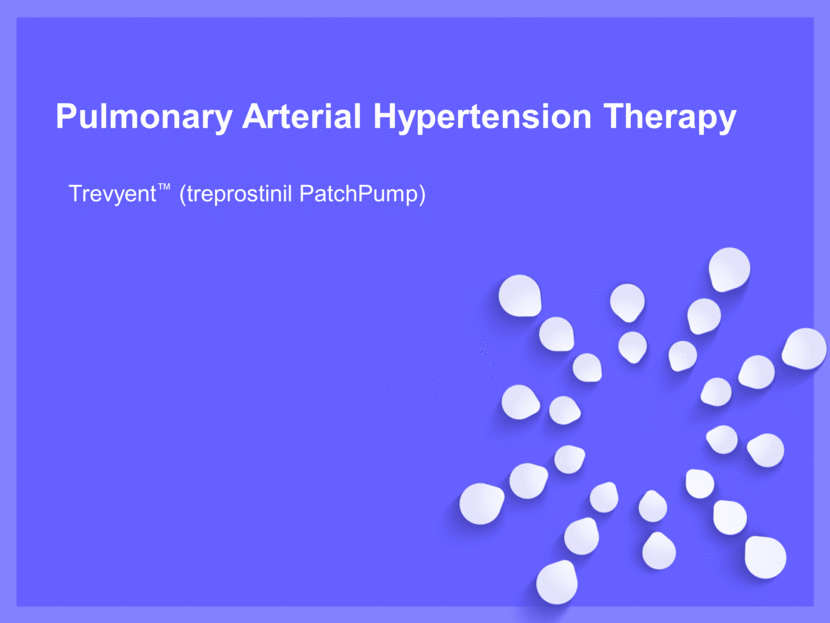
Progressive, life changing and life-threatening disease Orphan indication with ~30,000 patients diagnosed in the U.S. Fewer than 200 treatment centers in the U.S. Remodulin (treprostinil - United Therapeutics) is the market leading prostacyclin therapy 9 Our Primary Target – Pulmonary Arterial Hypertension
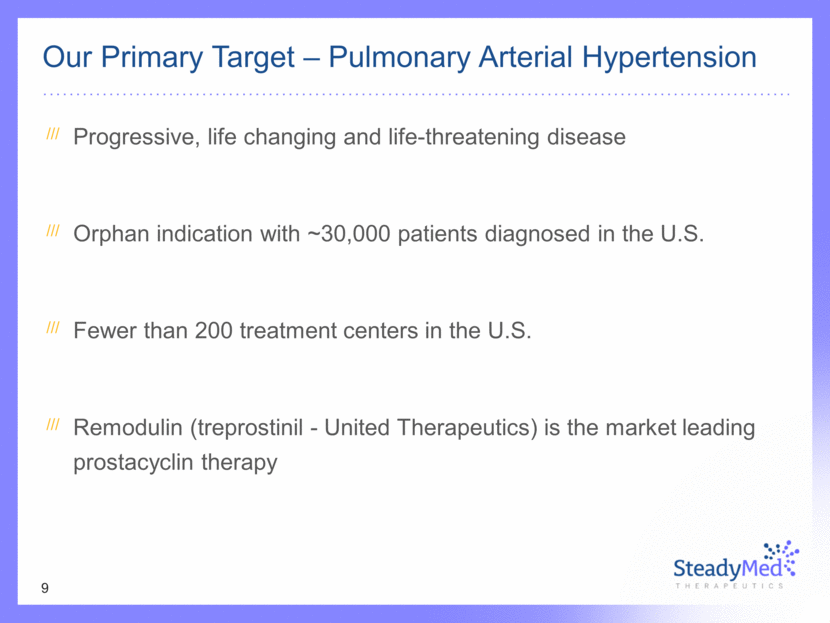
Progressive, life-changing and life-threatening disease Orphan indication with ~30,000 patients diagnosed in the U.S. Fewer than 200 treatment centers in the U.S. Remodulin (treprostinil - United Therapeutics) the leading prostacyclin therapy Annual average cost of Remodulin is ~$180,000 per patient Our Primary Focus– Pulmonary Arterial Hypertension Change in pulmonary vasculature with disease progression leading to right sided heart failure 10
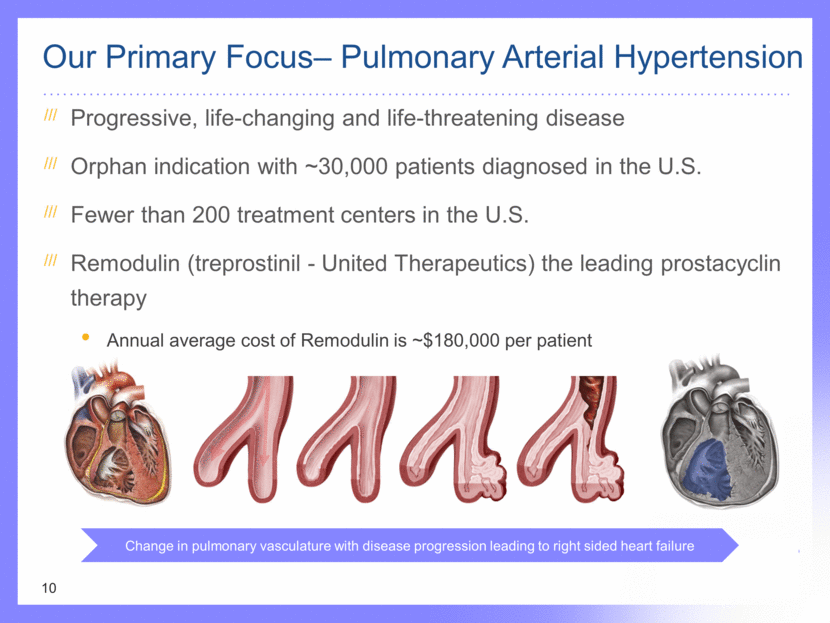
Pumps not designed for PAH or treprostinil Complex programming and error prone filling Infusion system complications in 28% of patients in controlled clinical studies Subcutaneous Infusion site pain in 85% of patients We believe may be linked to the meta-cresol preservative IV pump reservoir requires drug dilution Incorrect dosing possible Non-aseptic technique can cause blood stream infection (BSI) and sepsis Not water resistant Back-up pump needed 11 Administration System Limitations of Remodulin (parenteral treprostinil)
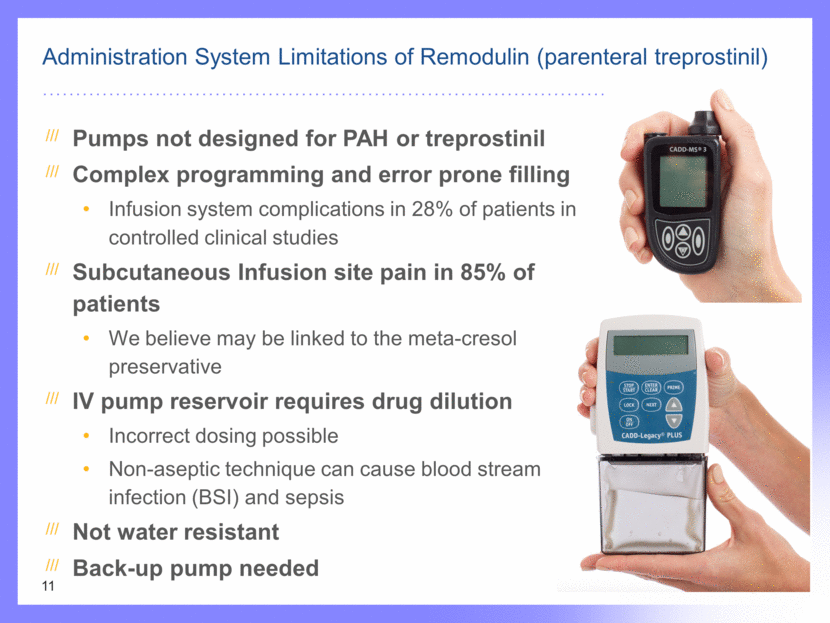
Convenient and ready-to-go No patient filling; aseptically pre-filled with treprostinil 48 hour duration before disposal and replacement Simple dosing with no programming Pre-programmed at site of manufacture No dosing buttons prevents tampering or accidental bolus For SC and IV therapy No need for diluents Preservative free We believe may reduce SC infusion site pain seen with Remodulin Compact and water resistant 12 Addressing The Limitations of Existing Therapy
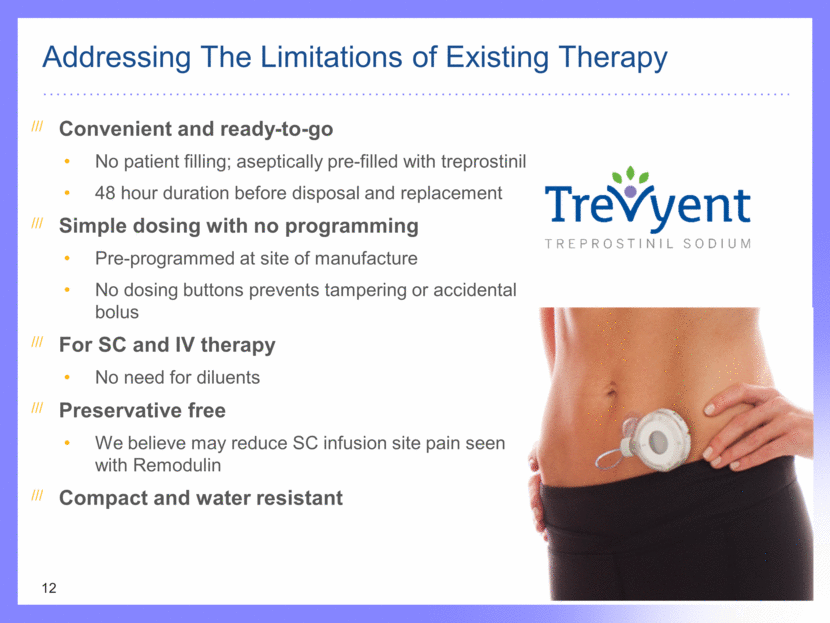
13 PCB – controls delivery rate and dose, sensors provide visible and audible feedback to patient ECell – an expanding battery that acts as the ‘motor’ in the PatchPump to drive the piston Piston – compresses the collapsible drug container to deliver drug through a soft cannula Drug container – aseptically filled with sterile liquid drug at site of manufacture Infusion Set – delivers drug subcutaneously or intravenously 1 2 3 4 5
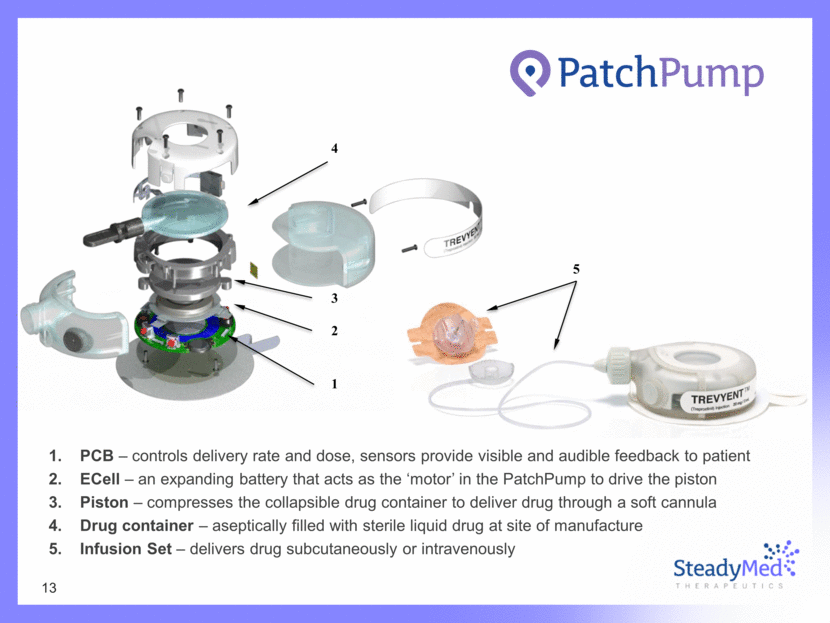
Trevyent™ - Delivery Performance 14 Tested according to IEC 60601-2-24 “Particular requirements for the basic safety and essential performance of infusion pumps and controllers” Analytical Balance connected to a P C Infusion Set Infusion S et N eedle PatchPump Liquid L evel Collection V essel
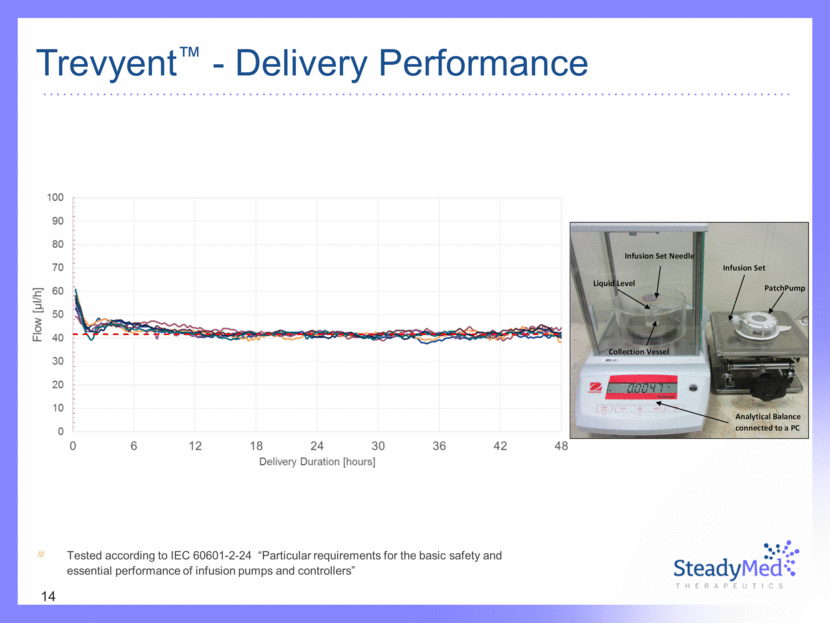
15 Comparable Dosing Profile For Treprostinil PatchPump data from early-prototype POC PK study (Shaked et al., Pharm Res, 2015) Key PK parameters comparable to Remodulin literature
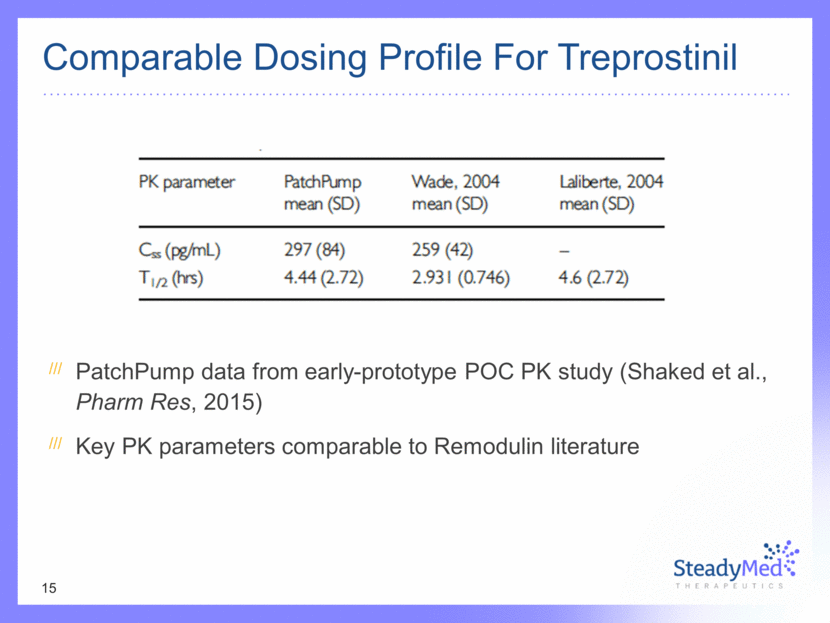
2 year program of 8 Human Factors studies completed Goal – Design Trevyent specifically for treprostinil and for patients with PAH Refine Trevyent design in an iterative manner to identify and mitigate safety issues and validate usability 148 subjects in U.S. and Europe - 92 PAH patients, 33 PAH Physicians, 23 other Met with CDRH* and DMEPA* in November 2014 to review HF program Usability of Trevyent validated Study Complete Goal Study Complete Goal 1 Ethnographic research 5 Full simulated use 2 User interface evaluation 6 User interface evaluation 3 User interface evaluation 7 Full simulated use 4 Wearability preferences 8 Final Validation Trevyent Usability Validated with PAH Patients 16 * Center for Devices and Radiological Health (CDRH), Division of Medical Error Prevention and Analysis (DMEPA)
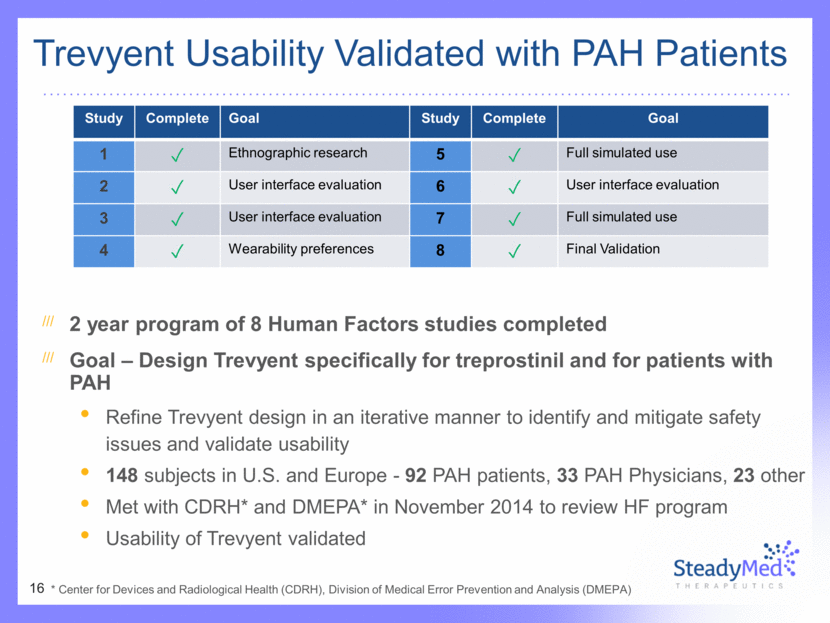
Registration batches are currently being manufactured Aseptic filling – Nova Laboratories (UK), Device assembly - Bespak Europe (UK) Several strengths are being tested for drug stability in long term storage conditions inside the final device Trevyent Manufacturing 17

Next Generation PatchPump 18
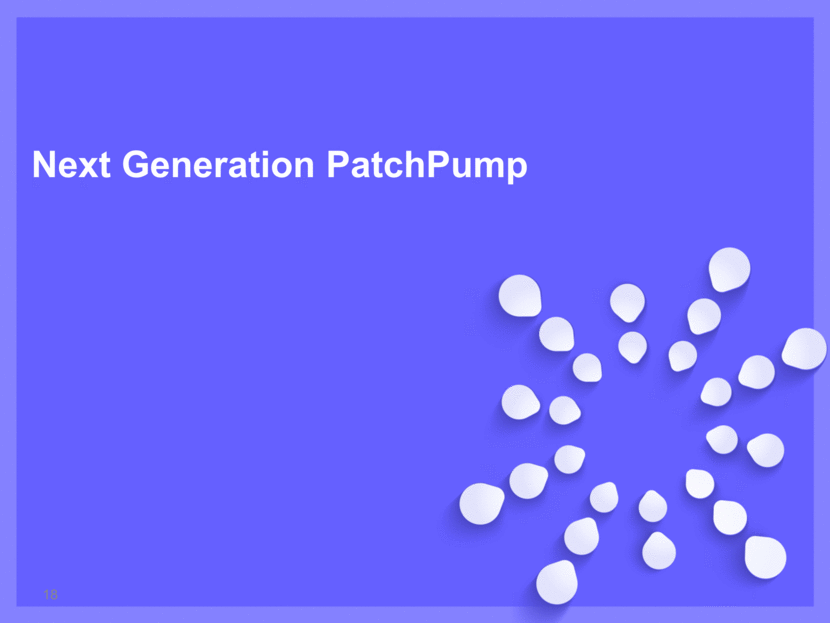
19 Auto Injectors - Limitations ~1 ml Volume Seconds (~5-10) Infusion duration Hand held User case Low (narrow gauge needle, fast injection, spring) Drug viscosity Some of the biologic drugs, particularly monoclonal antibodies, require large volumes to be injected. PEGylation and high concentrations can also increase viscosity. In order to inject a large drug volume, there are two options: Increasing the concentration Increase in viscosity High forces due to thinner needle requirements which resist flow due to ‘viscous drag’ Can increase injection duration to unacceptable periods Glass syringe can break Increasing the volume Increase flow rate which can be painful Increase injection duration can be uncomfortable to user (maintain injector position)
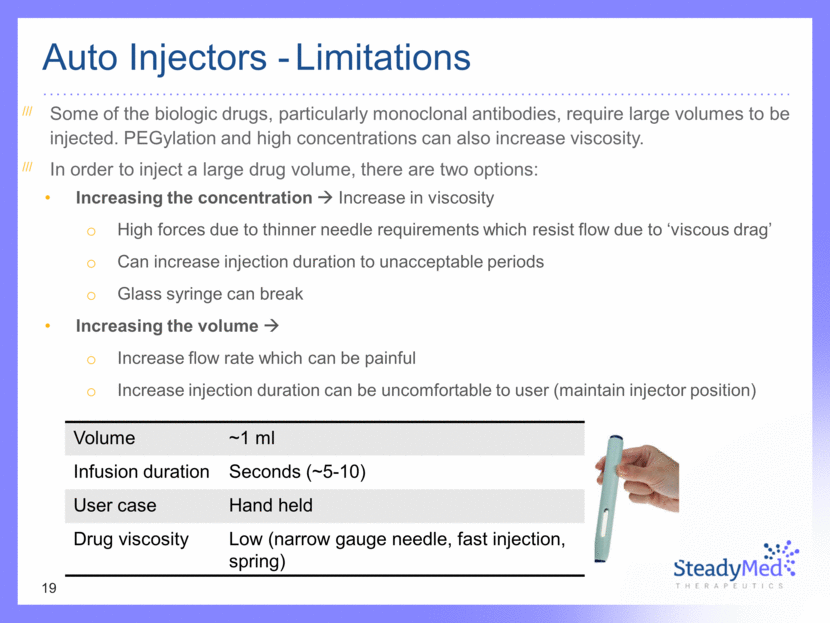
Viscosity vs Concentration 20
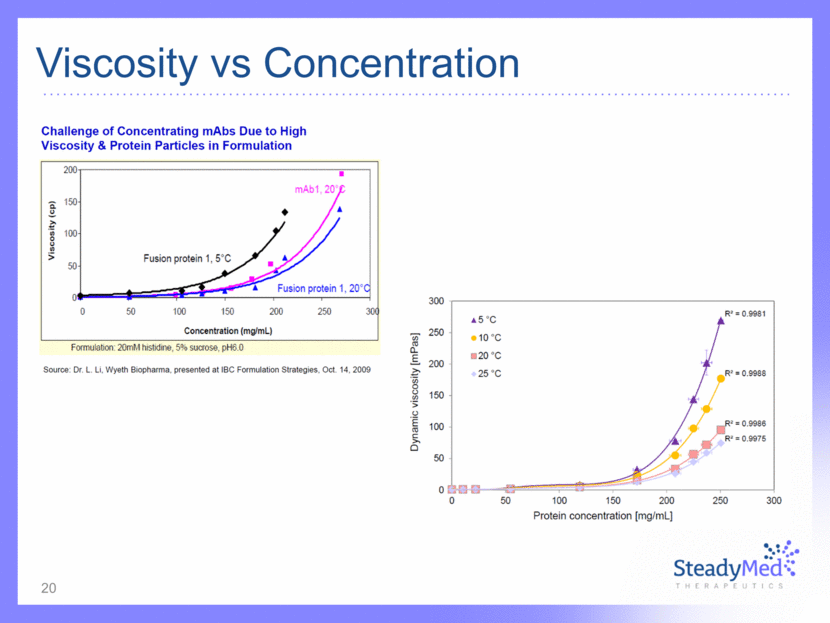
Glide Forces vs Viscosity 21

New class of drug delivery device that can be customized to subcutaneously inject doses far larger than today’s syringes or auto injectors. Does not need to be manually held in position during injection, and could contain a larger drug reservoir. Normally designed to deliver its payload promptly, unlike an infusion pump in which the duration of delivery is a key parameter in the therapy (such as a constant, low flow rate). Such a device will contain large primary container, integrated cannula system and User interface features to indicate injection phases 22 Bolus Injectors – Overview > 2ml Volume Minutes / hours Infusion duration Wearable (patch, clip, carried) User Operation High (“many tens of cP”) Drug viscosity

23 Bolus Injector - Overview Activation button Form factor & aesthetic follow current PatchPump, with modifications for integrated cannula inserter LED and drug viewing window Status button Skin Adhesion Activation Button
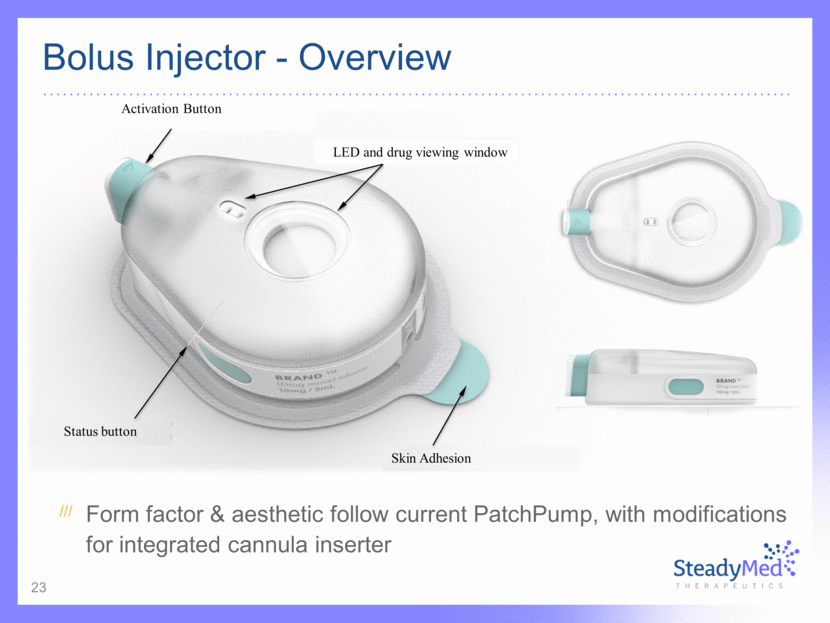
24 Operating Principles Pressing the activation button inserts the cannula, opens the drug path and activates the device. Soft Cannula inserted SC, insertion needle is retractable Actuator pushes piston against flexible container wall, generating positive pressure inside the primary container Drug flows from the container through the cannula LEDs and Buzzer signal for injection phases
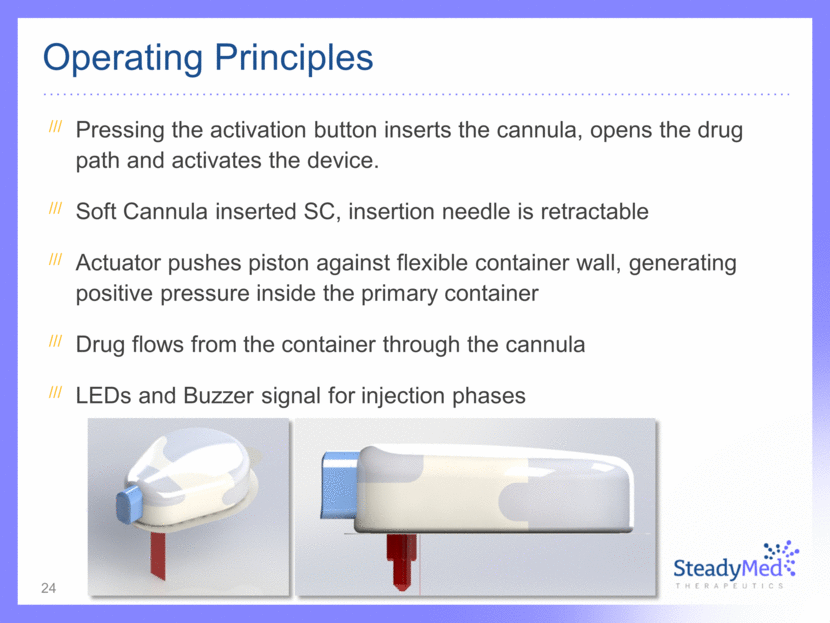
25 Use Sequence
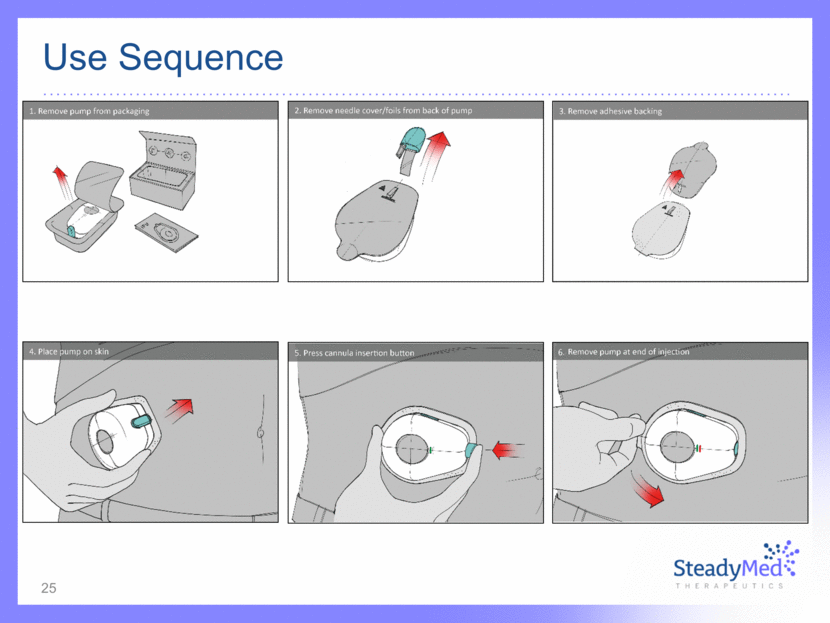
Cannula insertion via retractable needle Cannula and needle penetration Needle reaches its maximal depth Needle retraction leaving Cannula inside the skin Insertion forces and durations are similar to commercial inserters Integrated Cannula System 26 Insertion time Insertion Time (Adjusted for Depth) ICS1 ICS2 Orbit Inserter Quick-serter Accu-Chek Mio

Volume: ~2.5 ml Single channel for drug filling & air extraction Wide channel diameter designed to enable filling of viscous formulations Blister-to-base sealing by impulse welding Septum sealing achieved by using ribs Primary Container - Trevyent Base Plate (COP) Septum (Chlorobutyl) Blister (COP)
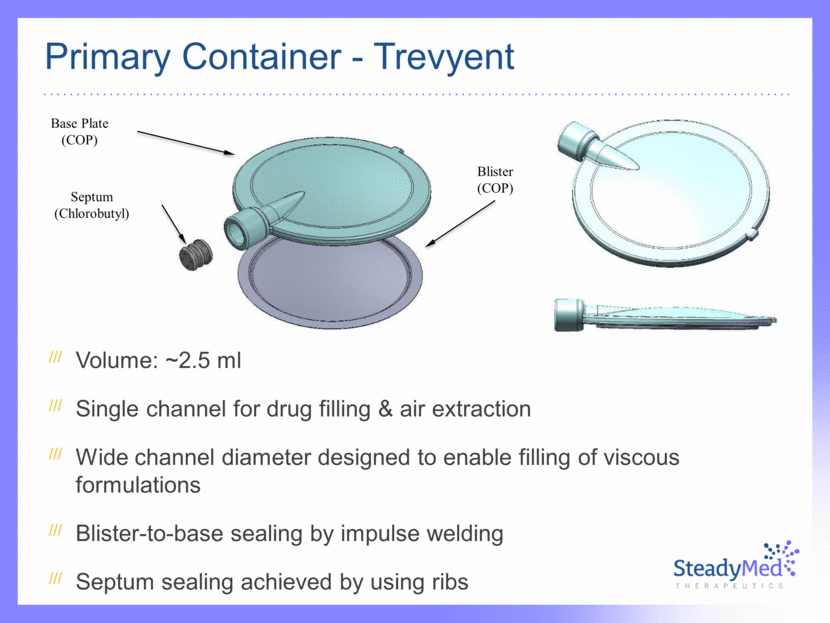
Leveraging current primary container technology to allow higher volumes High Volume Primary Container 28 ~2.5 ml (Trevyent) 10 ml 5 ml

High Volume Primary Container 29 Primary container geometry allows linear flow profile throughout the infusion duration and minimizing the dead volume Adequate flow linearity was demonstrated in 5 and 10ml volumes Primary container prototypes flow tests with external motor rig 0 5 10 0 5 10 15 20 25 30 35 40 45 Volume [ml] Travel [Arbitrary Units] PC3 PC4 PC5 PC1 PC2

Rapid Actuation 30 Ecell technology allows slow and medium accurate dosage range To allow fast delivery, fast actuator is required in order to provide the required speed, stroke and force Actuator requirements are driven by infusion rate, total delivered volume, primary container geometry, liquid viscosity and tubing / Cannula dimensions.

Pump Actuation Force A Lloyd machine was employed to apply constant force to the actuators and the required travel was recorded 0% 25% 50% 75% 100% 0 5 10 15 20 Travel Time (min) Extension vs time against controlled backload A2 A1
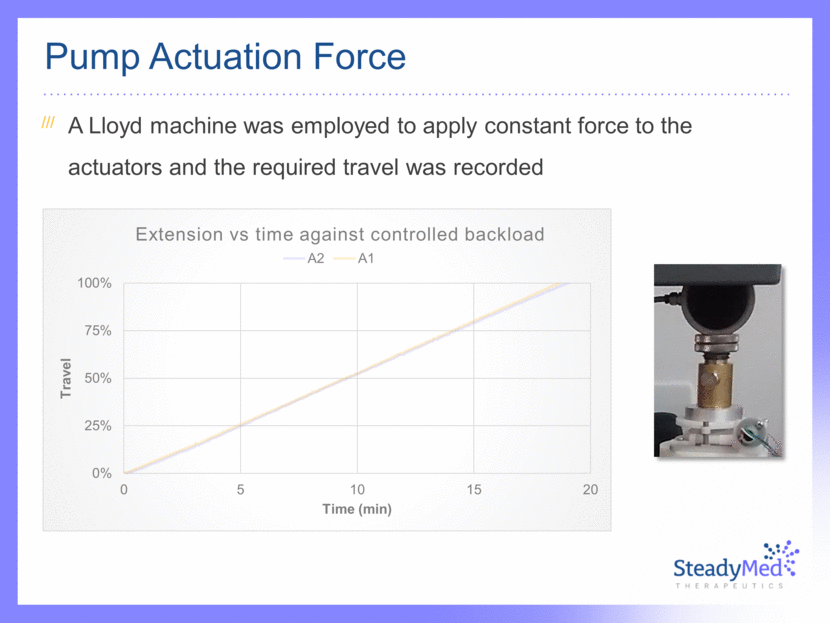
Bolus injector PoC models were tested for rapid injection High viscous liquids were delivered at different rates Bolus Injector Testing 0% 25% 50% 75% 100% 0 5 10 15 20 25 Time (min) Mass output vs time – 75 cP / 27 g Cannula PES1 PES2 PEC2
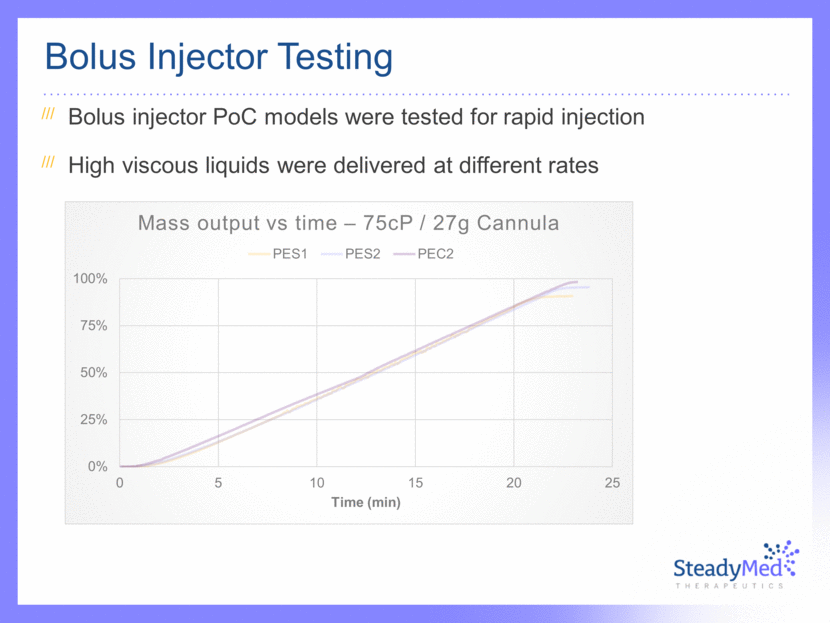
Trevyent® for pulmonary arterial hypertension (PAH) Treprostinil and PatchPump combination Designed to overcome the limitations of market leader Remodulin® (treprostinil) Expect to file NDA Q3 2016 SteadyMed to commercialize in U.S. Licensed to Cardiome for Europe, Canada and Middle East Expect to file MAA H2 2016 33 Summary – Trevyent
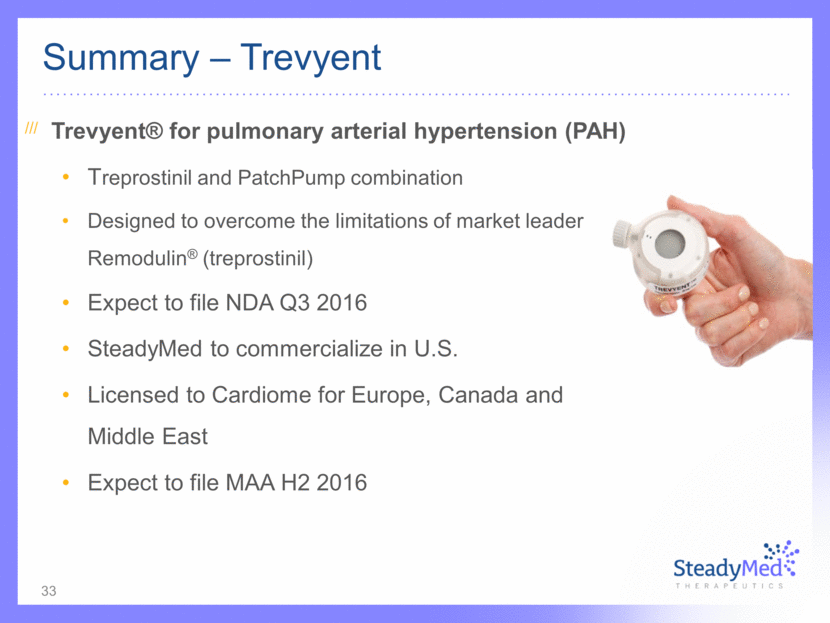
Conclusions – Next Generation PatchPump 34 Clear need for Bolus injectors technology High volumes, high viscosity, short infusion duration Leveraging existing primary container technology allows reaching high volumes Fast actuation mechanisms allow fast delivery under high loads Integrated Cannula insertion system provides compact design and improved usability
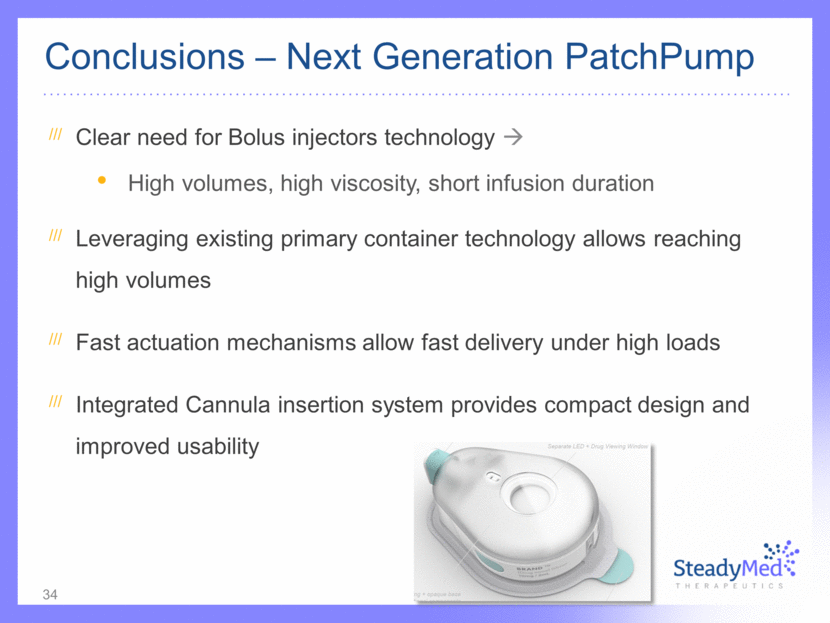
35 Thank you
